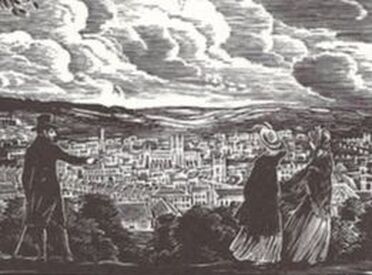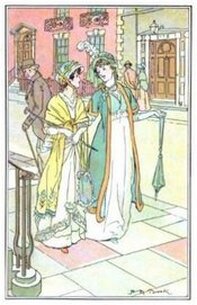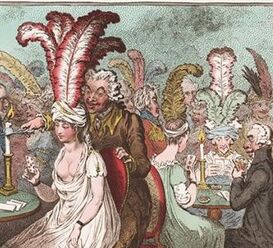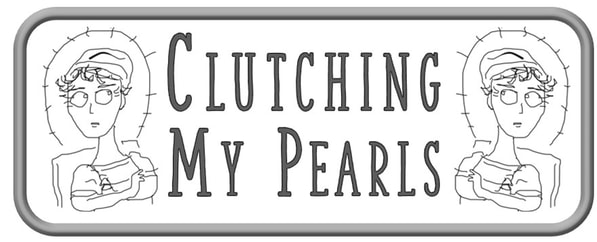| In today's post we're looking at a five volume novel, The Bristol Heiress, by Eleanor Sleath. First, some coincidences between this novel and Jane Austen's Northanger Abbey. Then, a bit about the author, and a real-life Bristol heiress. For more posts about now-obscure 18th century authors, click the category "Authoresses" to the right. |

In volume I of The Bristol Heiress, Mr. Griffiths, a charming and handsome young clergyman, goes walking with the heroine and her friend. He points out the beauties of the landscape to them. Later, he also explains the principles of drawing and perspective to the young heroine--just like Henry Tilney. In Northanger Abbey, Catherine Moreland "confessed and lamented her want of knowledge," so Henry Tilney "talked of foregrounds, distances, and second distances—side-screens and perspectives—lights and shades." Caroline Percival, the Bristol heiress, “knew little of design, and less of colouring; and in the arts of grouping and perspective, she was strangely deficient. Mr. Griffiths "united a thorough knowledge of the science and a thorough fondness for it."
Northanger Abbey's Isabella Thorpe says: "For heaven’s sake! Let us move away from this end of the room. Do you know, there are two odious young men who have been staring at me this half hour. They really put me quite out of countenance."
A secondary character in the novel is named Miss Moreland, though she is a foil for the heroine, not the heroine herself. The author of The Bristol Heiress and Henry Tilney's sister share a first name: Eleanor.

As we know, Jane Austen's manuscript for Northanger Abbey, then called Susan, had been sold to the publisher Benjamin Crosby in 1803. He didn't publish it, she wrote to him about it in 1809 and she finally bought it back from him in 1816. We know there had to have been some revisions. She changed the heroine's name and hence the title of the book. Scholars surmise that she dropped the name "Susan" because another book of the same name had come out recently. She added a mention of Maria Edgeworth's book Belinda, which was published in 1801 while Susan sat on the shelves at the publisher's.
But we do not know to what extent Austen made other revisions. She was still apparently unsatisfied with it, and worried that the entire idea of a spoof on gothic novels was now dated, even "obsolete."
Northanger Abbey is the only novel for which Austen wrote a preface and it is just a very brief author's note. (More typically, an author's note of this period would ask the public's indulgence, ie, to please give the book a kind reception, along with an assurance that the story upholds the highest moral standards, and does not give a sanction to vice. Austen evidently felt she could forego this practise.)
In her note, Austen took a little jab at Crosby without naming him, writing: "This little work was finished in the year 1803, and intended for immediate publication. It was disposed of to a bookseller, it was even advertised, and why the business proceeded no farther, the author has never been able to learn. That any bookseller should think it worth-while to purchase what he did not think it worth-while to publish seems extraordinary."
She added, "the public are entreated to bear in mind that thirteen years have passed since it was finished, many more since it was begun, and that during that period, places, manners, books, and opinions have undergone considerable changes."
Although Austen wrote this brief preface, she obviously still had doubts about publishing the book, and put it back on the shelf. It was not published until after her death in 1817.
So, unless one surmises that some or all of the similarities in The Bristol Heiress that I mentioned above were only added to the manuscript after Austen got it back the year before she died, there is no way that The Bristol Heiress could have influenced Northanger Abbey. Likewise, there is no way Northanger Abbey could have influenced The Bristol Heiress because in 1809, the manuscript was sitting on a shelf and Eleanor Sleath could not have seen it. Eleanor Sleath's novel was published by Lane, Darling & Co. It would have been quite tantalizing if it had been published by Crosby & Co., that is, brought out by the publisher who held the unpublished manuscript of Susan on its shelves, but it was not.

I haven't read the Orphan but here is a discussion of it by Ellen Moody, who wrote the foreword for a 2014 re-issue.
The scholars Rebecca Czlapinski and Eric C. Wheeler have pointed out that Catherine Morland mentions the very gothic names "Laurentina" and "St. Aubin" from the Orphan when she talks to Isabella Thorpe. Click here for a pdf chapter of their discussion of the Northanger--Orphan connection, along with a biography of Eleanor Sleath.
Rebecca Czlapinski's research into the interesting life story of Eleanor Sleath (1770-1847) is also available at her website SleathSleuth. Sleath was left in debt and with a baby boy after her husband died and later in life there were rumours about her and a married clergyman. Looks like the rumours were true.
Most of Sleath's novels were gothic novels. The Bristol Heiress is a sentimental novel with a short gothic tale interposed into the fifth volume, which I'll discuss briefly in the next post.
I had wondered if the Bristol Heiress novel owed anything to the real-life Bristol heiress, Clementina Clerke, whose elopement—or abduction—from a Bristol boarding school caused a sensation in 1791. She is a real-life example of someone who inherited a West Indian fortune from a rich uncle. You can read the true story here at Naomi Clifford’s website. I also came across a reference to a portrait of Clementina Clerke painted by the artist Samuel Woodforde but have been unable to find this portrait online.
The rich uncle was a common figure in 18th-century novels, very often an offstage character, who conveniently dies and leaves a large fortune. Eleanor Sleath uses this handy solution for one of her minor characters in The Bristol Heiress. We learn that: “A friend of Darnley’s, hang the fellow for his good luck, an East Indian Director, a collateral branch of his own family, lately deceased, has left him, with the exception of a few legacies, his sole heir; and his property, on a very moderate calculation, is supposed to amount to above eighty thousand pounds.”
But I see no connection between Caroline and Clementina.

The Bristol Heiress, or The Errors of Education by Eleanor Sleath was published in 1809. The subtitle makes it clear that this is a story about the consequences of not educating your daughters properly. Many books of this period take up this theme, including Austen's Mansfield Park. Sleath's tale received a good review, although the first sentence must have caused Sleath a little bit of alarm when she read it. It starts with a sneer: “This is one of those numerous publications which issue almost daily from the press, striving, seemingly in vain, to sate the appetite of the public for novels and romances.” But then the reviewer goes on to say: “It were greatly to be wished that all compositions of this kind were calculated, like the present work, to inculcate some useful truth; for then that class of readers, who take up a book merely for the most indolent exercise of the attention, would often be betrayed into instruction, and pass their hour with at least the possibility of receiving some benefit.” This is the highest praise a reviewer of the day could bestow: commending the novel for its moral value.
“The authoress of this work undertakes to shew, that those persons are greatly mistaken who educate their daughters wholly with a view to fashionable life: for that happiness does not consist in splendid pleasures, but rather in the rational exercise of the benevolent affections. This is exemplified in the history of Caroline Percival, the daughter of a banker at Bristol, a person of an ancient but decayed family, who had himself risen to opulence through his marriage with the daughter of a tradesman, and was now eagerly anxious to raise his only daughter… into the first ranks of the gay and fashionable world."
More about the plot of The Bristol Heiress in my next post.

 RSS Feed
RSS Feed